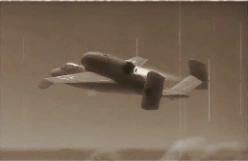The Heinkel He-162 A-2 «Salamander» was a German jet fighter aircraft in service with the Luftwaffe from 1944 to 1945. A Tier 5 aircraft, the He 162 A-2 has an upfront cost of 1,430,000 ![]() . (Wow this is outdated, and I'm too lazy to update it.)
. (Wow this is outdated, and I'm too lazy to update it.)
Design, Development, & History[]
Heinkel had designed a relatively small, 'sporty'-looking aircraft, with a sleek, streamlined fuselage. Overall, the look of the plane was extremely modernistic for its' time, appearing quite contemporary in terms of layout and angular arrangement even to today's eyes. The BMW 003 axial-flow turbojet was mounted in a pod nacelle uniquely situated atop the fuselage directly aft of the cockpit. Twin vertical tailfins were mounted at the ends of highly dihedralled horizontal tailplanes to clear the jet exhaust, a high-mounted straight wing with a forward-swept trailing edge and shallow dihedral, an ejection seat was provided for the pilot, and tricycle landing gear that retracted into the fuselage. The prototype flew within an astoundingly short period of time: the design was chosen on 25 September and first flew on 10 April less than 90 days later. This was despite the fact that the factory in Wuppertal making Tego film plywood glue — used in a substantial number of late-war German aviation designs whose airframes were meant to be constructed mostly from wood — had been bombed by the Royal Air Force and a replacement had to be quickly substituted, without realizing that the replacement adhesive would turn out to be highly corrosive to the wooden parts it was intended to be fastening.
The third and fourth prototypes, which now used an "M" for "Muster" (model) number instead of the older "V" for "Versuchs" (experimental) number, as the He 162 M3 and M4, after being fitted with the strengthened wings, flew in mid-January 1945. These versions also included small aluminium wingtip "droops", reportedly designed by Alexander Lippisch and known in German as Lippisch-Ohren ("Lippisch Ears"), in an attempt to cure the stability problems via decreased dihedral. Both were equipped with two 30 mm (1.18 in) MK 108 cannons in the He 162 A-1 anti-bomber variant; in testing, the recoil from these guns proved to be too much for the lightweight fuselage to handle, and plans for production turned to the A-2 fighter with two 20 mm MG 151/20 cannons instead while a redesign for added strength started as the A-3. The shift to 20 mm guns was also undertaken because the smaller-calibre weapons would allow a much greater amount of ammunition to be carried.
The He 162,2 was originally built with the intention of being flown by the Hitler Youth, as the Luftwaffe was fast running out of pilots. However, the aircraft was far too complicated for any but a highly experienced pilot. An unpowered two-seat glider version, designated the He 162S (Schulen), was developed for training purposes. Only a small number were built, and even fewer delivered to the sole He 162 Hitler Youth training unit to be activated (in March 1945) at an airbase at Sagan. The unit was in the process of formation when the war ended, did not begin any training, and it is doubtful that more than one or two He 162S gliders ever took to the air.
The Hinterbrühl underground production was captured in April 1945 Various changes had raised the weight over the original 2,000 kg (4,410 lb) limit, but even at 2,800 kg (6,170 lb), the aircraft was still among the fastest aircraft in the air with a maximum airspeed of 790 km/h (491 mph) at sea level and 839 km/h at 6000 meters (521 mph @ 19,680 ft), but could reach 890 km/h (550 mph) at sea level and 905 km/h (562 mph) at 6,000 m (19,690 ft) using short burst extra thrust. The short flight duration of barely 30 minutes - only somewhat better than the even shorter 7.5 minute flight duration of the faster-flying Me 163B rocket fighter - was due to only having a single 695 litre (183 US gallon) capacity flexible-bladder fuel tank in the fuselage directly under the engine's intake. He 162 construction facilities were at Salzburg, the Hinterbrühl, and the Mittelwerk.
Skins[]
Aircraft prototype camouflage: Shoot down 350 players
